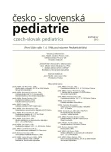Ligneous conjunctivitis, hydrocephalus and protracted respiration infections in a patient with plasminogen deficit
Authors:
J. Čižmár; J. Behúnová; Ľ. Podracká
Authors‘ workplace:
I. Klinika detí a dorastu LF UPJŠ a DFN, Košice, prednosta prof. MUDr. Ľ. Podracká, CSc.
Published in:
Čes-slov Pediat 2012; 67 (1): 38-42.
Category:
Case Report
Overview
We report a rare case of an infant with internal hydrocephalus, pseudomembranous conjunctivitis and recurrent respiratory infections associated with plasminogen deficiency. Both, systemic and topical treatment were ineffective. Repeated attempts on ventriculoperitoneal shunting had to be performed due to non-inflammatory obstruction of drainage system. Pseudomembranous conjunctivitis was the most prominent clinical finding. Bilateral thick yellow fibrin membranes on the palpebral surfaces were present. Suspicion of defective fibrinolysis was supported by histological finding of „pure“ fibrin from the conjunctivas coating membranes. Severely reduced activity of plasminogen (14.4%, norm 75–150%) was confirmed.
Plasminogen deficit type I is a rare systemic disease characterized by a marked defect of extracellular fibrinolysis that leads to the formation of ligneous (fibrin rich) pseudomembranes at mucosae. Most common clinical manifestation is ligneous conjunctivitis, although pseudomembranes can also form in respiratory tract, gastrointestinal tract etc. Diagnosis of hypoplasminogenemia is based on typical clinical manifestation and evidence of quantitative or qualitative defect of plasminogen activity. Treatment of ligneous conjunctivitis is intricate; topical plasminogen concentrate holds promise. In systemic affection, replacement therapy with human plasminogen can be efficient.
Key words:
plasminogen deficit, ligneous conjunctivitis, pseudomembranes, congenital hydrocephalus
Sources
1. Dykes D, Polesky H. Incindence of the PLG *Q0 allele in human populations. In: Mayr W, ed. Advanced in Forensic Haemogenetics. Berlin: Springer, 1988: 261–264.
2. Weidinger S, PatutschnickW, Schwarzfischer F. Further evidence of a silent plasminogen (PLG) allele in two paternity cases. Z Rechtsmed 1988; 101: 99–104.
3. Tait RC, Walker ID, Conkie JA, et al. Isolated familial plasminogen deficiency may not be a risk factor for thrombosis. Thromb Haemost 1996; 76: 1004–1008.
4. Okamoto A, Sakata T, Mannami T, et al. Population-based distribution of plasminogen activity and estimated prevalence and relevance to thrombotic diseases of plasminogen deficiency in the Japanese: the Suita Study. J Thromb Haemost 2003; 1: 2397–2403.
5. http://www.orpha.net/orphacom/cahiers/docs/GB/Prevalence_of_rare_diseases_by_alphabetical_list.pdf.
6. Thachil J, Reeves G, Kaye S. Ligneous conjunctivitis with plasminogen deficiency. Br J Haematol. 2009 May; 145(3): 269.
7. Schott D, Dempfle CE, Beck P, et al. Therapy with a purified plasminogen concentrate in an infant with ligneous conjunctivitis and homozygous plasminogen deficiency. Engl J Med 1998; 339(23): 1679–1689.
8. Weinzierl MR, Collmann H, Korinth MC, et al. Management of hydrocephalus in children with plasminogen deficiency. Eur J Pediatr Surg 2007 Apr; 17(2): 124–128.
9. Mehta R, Shapiro AD. Plasminogen deficiency. Haemophilia 2008; 14: 1261–1268.
10. Booth NA, Bachmann F. Plasminogen-plasmin system. In: Coleman RW, Marder VJ, Clowes AW, et al. Hemostasis and Thrombosis: Basic Principles and Clinical Practice. Philadelphia: Lippincott Williams & Wilkins, 2006: 335–364.
11. Mirshahi S, Soria J, Nelles L, Soria C, Faure JP, Pouliguen Y, Mirshahi M. Plasminogen activators in human corneal fibroblasts: secretion, cellular localization, and regulation. Fibrinolysis 1996; 10: 255–262.
12. Ploplis VA, Carmeliet P, Vazirzadeh S, et al. Effects of disruption of the plasminogen gene on thrombosis, growth, and health in mice. Circulation 1995; 92: 2585–2593.
13. Shigekiyo T, Uno Y, Tomonari A, et al. Type I congenital plasminogen deficiency is not a risk factor for thrombosis. Thromb Haemost 1992; 67: 189–192.
14. Watts P, Suresh P, Mezer E, et al. Effective treatment of ligneous conjunctivitis with topical plasminogen. Am J Ophthalmol 2002; 133: 451–455.
15. Schuster V, Hügle B, Tefs K. Plasminogen deficiency. J Thromb Haemost 2007; 5: 2315–2322.
16. Lee WB, Himmel K. Fresh froyen plasma treatment of ligneous conjunctivitis: use of heparin and allogenic serum. Cornea 2009 Jan; 28(1): 122–123.
17. Gurlu VP, Demir M, Alimgil ML, et al. Systemic and topical fresh-frozen plasma treatment in a newborn with ligneous conjunctivitis. Cornea 2008 May; 27(4): 501–503.
18. Scully C, Allen C, Erseven G, et al. Oral lesions indicative of plasminogen deficiency (hypoplasminogenemia). Oral Surg Oral Med Oral Pathol 2001; 91: 334–337.
19. Tefs K, Gueorguieva M, Klammt J, et al. Molecular and clinical spectrum of type I plasminogen deficiency: a series of 50 patients. Blood 2006; 108: 3021–3026.
20. Suzuki T, Ikewaki J, Iwata H, et al. The first two Japanese cases of severe type I congenital plasminogen deficiency with ligneous conjunctivitis: Succesful treatment with direct thrombin inhibitor and fresh plasma. Am J Hematol 2009; 84: 363–365.
Labels
Neonatology Paediatrics General practitioner for children and adolescentsArticle was published in
Czech-Slovak Pediatrics

2012 Issue 1
Most read in this issue
- When to search for inhereted thrombophilia risk factors in children?
- Influenced pain by children dental treatment
- The effect of thumb sucking on splanchocraniums development in childhood
- Thymidin kinase – suitable marker for diagnostics and follow up in childhood leukemia
